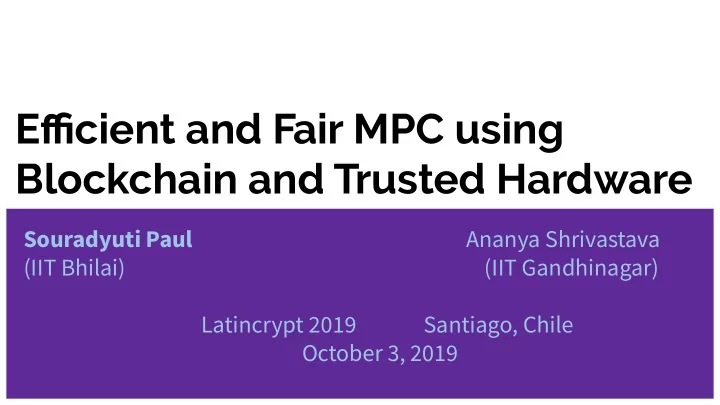

Efficient and Fair MPC using Blockchain and Trusted Hardware Souradyuti Paul Ananya Shrivastava (IIT Bhilai) (IIT Gandhinagar) Latincrypt 2019 Santiago, Chile October 3, 2019
Outline Multiparty Computation (MPC) ❏ Security Property of MPC: Privacy, Correctness, Fairness ❏ Various Components ❏ Blockchain ❏ Trusted Hardware ❏ Core MPC having privacy and correctness security ❏ Fair MPC Protocol using Blockchain and Trusted Hardware: CGJ+ Protocol ❏ Attack on CGJ+ Protocol ❏ Our Construction ❏ Results ❏
Multiparty Computation (MPC) Definition (Informal) There are n parties P 1 , P 2 , …. , P n who do not trust each other. Each party P i has its own private input x i and there is a common function f (.) with n -bit input that every party wants to compute on their private data.
Security Property of MPC: Fairness Definition (Informal) An adversary can receive their output only if all honest parties receive output. An adversary can receive their output only if all honest parties receive output.
Component 1: Bulletin Board (Blockchain) Properties: Messages are permanently available. ● Messages are visible publicly to all the parties. ● Produces a publicly verifiable proof that the message is posted publicly. ● Generates proofs using an Authentication Scheme which can be publicly verified. ● Public Ledger BB
Component 2: Trusted Hardware Properties: It provides the private regions of memory -- known as enclaves -- for running ● programs. An enclave provides confidentiality and integrity of a program in the presence of ● adversarial environment. It provides attestation of the correct execution of a program using digital ● signatures. Example: Intel Sofuware Guard Extension (SGX) ●
Component 3: Core MPC having privacy and correctness security x, k 0 y, k 1 ct ct Here, ct= AE.Enc((k 0 , k 1 ), f(x,y))
Fair MPC Protocol using BB and Trusted Hardware: CGJ+ Protocol 1 P 0 P 1 Secrets: x y Compute: f (x,y) 1 Choudhuri, Arka Rai, et al. "Fairness in an unfair world: Fair multiparty computation from public bulletin boards." Proceedings of the 2017 ACM SIGSAC Conference on Computer and Communications Security . ACM, 2017.
CGJ+ Protocol: Stage 2 x, k 0 , com 0 y, k 1 , com 1 ct ct
Our Observation The security of CGJ+ protocol is proved (in the malicious model with dishonest ● majority) under the condition that the core MPC component π supports the privacy of the individual secrets, and the correctness of the output. While privacy is ensured using a secret-sharing scheme, achieving correctness of ● output requires expensive operations such as ZKP and commitment schemes. Can we break the fairness property of the CGJ+ protocol, if the core MPC component π is allowed to output an incorrect value?
Our Construction Designed a new fair protocol Γ, which works even if the internal component π ● returns an incorrect value. We reiterate that the origin of the attack in CGJ+ protocol is the release tokens (ρ 0 , ● ρ 1 ) being generated independently of the ciphertext. We remove the r elease tokens altogether from the protocol and generate a tag from ● BB using the ciphertext directly.
Our Construction: Stage 2 x, k 0 y, k 1 ct ct
Summary of Our Contribution Our first contribution is showing concrete fairness attacks on the protocols ● described in CGJ+, denoted by Π, and KMG 2 (stateless version of CGJ+) protocols, when the underlying protocol π allows incorrect output to be returned. Next, we design a new protocol Γ based on public ledger and trusted hardware, and ● prove that it is fair , even if π returns an incorrect value. We extended our work to design a stateless version of Γ, namely Υ, and also prove ● its fairness . 2 Kaptchuk, Gabriel, Matthew Green, and Ian Miers. "Giving State to the Stateless: Augmenting Trustworthy Computation with Ledgers." NDSS . 2019.
Results
Thank you.
Recommend
More recommend